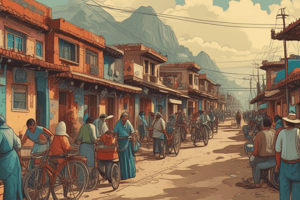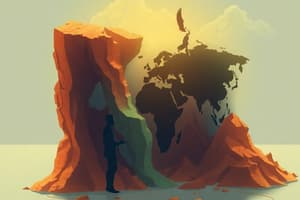Podcast
Questions and Answers
What defines someone as living in absolute poverty?
What defines someone as living in absolute poverty?
- They have an income below the average household income.
- They fall short of a certain minimum standard of living. (correct)
- They have lower income than the richest member of society.
- They cannot afford any luxury items.
Which of the following best describes relative poverty?
Which of the following best describes relative poverty?
- Falling behind the average income in society. (correct)
- Being unable to afford basic necessities.
- Having no access to government assistance.
- Being in debt due to spending habits.
What is a basic source of efficiency in a market system?
What is a basic source of efficiency in a market system?
- High taxation on the rich.
- A system of rewards and penalties. (correct)
- Government regulation of prices.
- Equal distribution of wealth among all citizens.
In the context of income distribution, how may the poor be viewed?
In the context of income distribution, how may the poor be viewed?
What challenge does poverty pose in defining economic classes?
What challenge does poverty pose in defining economic classes?
What income level defines the poverty line for a family of four as stated in 2017?
What income level defines the poverty line for a family of four as stated in 2017?
Which demographic group is most likely to fall below the poverty line?
Which demographic group is most likely to fall below the poverty line?
What was the main goal of the War on Poverty initiated in 1964?
What was the main goal of the War on Poverty initiated in 1964?
Which factor is NOT typically associated with higher rates of poverty?
Which factor is NOT typically associated with higher rates of poverty?
Relative poverty measures how much income a family has compared to what?
Relative poverty measures how much income a family has compared to what?
Economic inequality can best be described as what?
Economic inequality can best be described as what?
Which policy might be considered to achieve more income equality?
Which policy might be considered to achieve more income equality?
What is the primary challenge in addressing income distribution issues?
What is the primary challenge in addressing income distribution issues?
What is a key feature of Temporary Assistance to Needy Families (TANF)?
What is a key feature of Temporary Assistance to Needy Families (TANF)?
Which of the following describes a negative aspect of previous welfare programs?
Which of the following describes a negative aspect of previous welfare programs?
What is the mechanism behind a negative income tax?
What is the mechanism behind a negative income tax?
Which welfare program is delivered via an electronic benefits card?
Which welfare program is delivered via an electronic benefits card?
What is one proposed advantage of providing cash rather than in-kind transfers like food stamps?
What is one proposed advantage of providing cash rather than in-kind transfers like food stamps?
How did the design of earlier welfare programs before the 1990s impact work incentives?
How did the design of earlier welfare programs before the 1990s impact work incentives?
What was the approximate number of Americans receiving food stamps in 2017?
What was the approximate number of Americans receiving food stamps in 2017?
What is a characteristic of in-kind transfers?
What is a characteristic of in-kind transfers?
Flashcards
Absolute Poverty
Absolute Poverty
A state of poverty defined by falling below a minimum standard of living.
Relative Poverty
Relative Poverty
Poverty measured by falling significantly behind the average income.
Poverty Definition Challenges
Poverty Definition Challenges
Defining poverty is difficult, absolute or relative approaches each have limitations.
Income Inequality
Income Inequality
Signup and view all the flashcards
Market System & Inequality
Market System & Inequality
Signup and view all the flashcards
TANF (Temporary Assistance for Needy Families)
TANF (Temporary Assistance for Needy Families)
Signup and view all the flashcards
Welfare Programs (early 1990s)
Welfare Programs (early 1990s)
Signup and view all the flashcards
Food Stamps (electronic benefits card)
Food Stamps (electronic benefits card)
Signup and view all the flashcards
Negative Income Tax
Negative Income Tax
Signup and view all the flashcards
In-kind transfers
In-kind transfers
Signup and view all the flashcards
Welfare incentive issues
Welfare incentive issues
Signup and view all the flashcards
Minimum income level (guarantee)
Minimum income level (guarantee)
Signup and view all the flashcards
Internal tax rate for benefits
Internal tax rate for benefits
Signup and view all the flashcards
Poverty Line
Poverty Line
Signup and view all the flashcards
Who are the poor?
Who are the poor?
Signup and view all the flashcards
War on Poverty
War on Poverty
Signup and view all the flashcards
Progress in the War on Poverty
Progress in the War on Poverty
Signup and view all the flashcards
Inequality in the U.S.
Inequality in the U.S.
Signup and view all the flashcards
How much equality is desired?
How much equality is desired?
Signup and view all the flashcards
Policies to address inequality
Policies to address inequality
Signup and view all the flashcards
Sitting Bull Quote
Sitting Bull Quote
Signup and view all the flashcards
Study Notes
Economics: Principles and Policy
- Textbook title: Economics: Principles and Policy
- Version: 14th edition
- Authors: William J. Baumol, Alan S. Blinder, John L. Solow
- Slides prepared by: Philip Heap, James Madison University
Part 4: The Distribution of Income
- Part 4 focuses on the distribution of income
Chapter 20: Poverty, Inequality, and Discrimination
- Introduces the topic of poverty, inequality, and discrimination
- Includes an opening quote from Sitting Bull
An Opening Quote
- "The white man knows how to make everything, but he does not know how to distribute it." - Sitting Bull
Three Questions to Address
- How unequal are incomes in the U.S., and why?
- How can society decide how much equality it wants?
- What policies are available to achieve this goal?
The Facts: Poverty
- War on Poverty (LBJ in 1964)
- Poverty line: $3,000 (1964) and $24,858 (2017) for a family of four
- 12.3% fell below the line in a certain year
- Characteristics of the poor: Black, women, less educated, poorer health; one-third are children
- Progress made in poverty reduction (graph shown in presentation)
The Facts: Poverty (continued)
- Defining "poor": Absolute poverty- falling below a minimum standard of living
- Relative poverty- falling too far behind the average income
- No sharp distinction between poor and rich
- The rich becoming richer may drive the poor to be poorer
The Facts: Inequality
- Market systems naturally create or allow inequality
- Rewards and penalties (incentivizing harder work) are a core element of efficiency. Experiment discussed to get students to think of this issue.
- Distribution of household income in the U.S. in 2017 (table included)
The Facts: Inequality (continued)
- Income distribution over time (table with income shares in selected years)
- Greater inequality since approximately 1980
- Comparing U.S. to other rich countries: U.S. has higher inequality (more unequal) than most other industrialized nations (e.g., Denmark, Finland, Iceland)
Some Reasons for Unequal Incomes
- Difference in ability, work experience, intensity of work
- Risk-taking
- Compensating wage differentials
- Schooling and other training
- Inherited wealth
- Luck
The Facts: Discrimination
- Economic discrimination: factors receiving unequal payments for equal output
- Men are typically more productive than women; that alone does not necessarily indicate discrimination
- Incorrect measure of discrimination: comparing median incomes of different groups (table of median incomes in 2017)
The Tradeoff Between Equality and Efficiency
- Two opposing views on inequality:
-Conservative: inequality is a result of market mechanisms; government intervention may harm efficiency
- Liberal: a good society does not have high and rising inequality; government should impose policies to reduce inequality
- Trump Tax Cuts as an example of this tradeoff
Ideas for Beyond the Final Exam
- The tradeoff between equality and efficiency is a crucial consideration
- Policies that promote efficiency (high-reward systems) may have adverse effects on income equality
- Should society be more concerned with equality or efficiency?
Policies to Combat Poverty
- Education (boosts earnings, but can be difficult to provide quality education for poor children)
- Welfare programs (including TANF, which placed limits on the amount of time people could be on welfare)
- Food stamps (delivered via electronic methods)
- In-kind transfers
Policies to Combat Poverty (continued)
- Negative income tax (example with guaranteed income and internal tax rate)
- Earned income tax credit (EITC) -grants are proportionally to earnings
Other Policies to Combat Inequality
- Progressive income taxes (take a larger share of income from the rich)
- Death duties / taxes (limits wealth transfer to next generation)
- Other taxes: (e.g., sales, payroll, property taxes) are largely regressive. The U.S. tax system as a whole is considered to be slightly progressive.
Policies to Combat Discrimination
- Civil Rights Act of 1964 (outlawed discrimination) and establishment of the Equal Employment Opportunity Commission (EEOC)
- Affirmative action (efforts to locate and hire members of underrepresented groups.) Also may have controversies (quotas creating inefficiency)
A Look Back
- How well the market handles income distribution
- Market relies on marginal productivity principle to distribute income
- Scarce factors get higher prices than abundant ones
- Market distributes income unequally
Studying That Suits You
Use AI to generate personalized quizzes and flashcards to suit your learning preferences.




